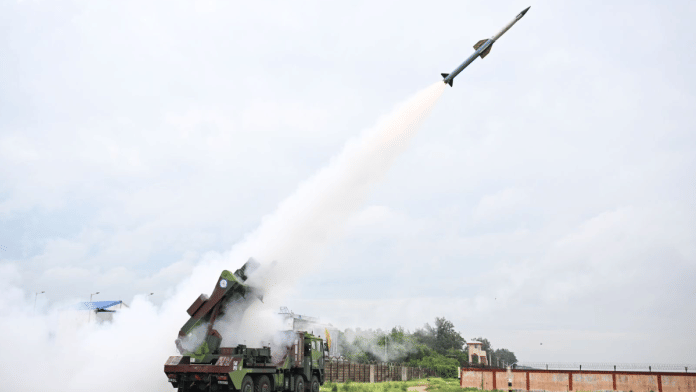New Delhi: In the first step towards Project Sudarshan Chakra, India has successfully conducted the maiden flight-tests of its Integrated Air Defence Weapon System (IADWS) off the coast of Odisha.
Conducted Saturday, the trials demonstrated the Defence Research and Development Organisation (DRDO) developed multi-layered system that brought together the Quick Reaction Surface-to-Air Missiles (QRSAM), Advanced Very Short Range Air Defence System (VSHORADS), and a Directed Energy Weapon (DEW) to defend against contemporary aerial threats.
A government statement Sunday said that the inaugural test involved three aerial targets: two high-speed fixed-wing UAVs and a multi-copter drone. Each was engaged simultaneously, with the QRSAM, VSHORADS and DEW performing flawlessly at different ranges and altitudes.
Maiden flight Tests of Integrated Air Defence Weapon System (IADWS) was successfully conducted on 23 Aug 2025 at around 1230 Hrs off the coast of Odisha.
IADWS is a multi-layered air defence system comprising of all indigenous Quick Reaction Surface to Air Missile (QRSAM),… pic.twitter.com/Jp3v1vEtJp
— DRDO (@DRDO_India) August 24, 2025
“All components of the weapon system, including the missile systems, drone detection and destruction system, command-and-control, communication, and radars performed flawlessly, which was confirmed by range instruments deployed at the Integrated Test Range, Chandipur, to capture the flight data,” the statement read.
Defence Minister Rajnath Singh congratulated the DRDO, the armed forces and the defence Industry for successful development of IADWS. “This unique flight test has established the multi-layered air-defence capability of our country and is going to strengthen area defence for important facilities against enemy aerial threats,” he posted on ‘X’.
Also Read: First-of-its kind tri-services conference Ran Samvad to take place in Army War College next week
How it operates
The IADWS functions as a layered, network-centric shield that combines kinetic interceptors and directed-energy weapons under a unified command architecture.
At its centre is the Centralised Command and Control Centre (C2C2), which integrates radar and electro-optical sensor feeds, generating a real-time air picture. Based on parameters such as velocity, altitude, radar cross-section and flight path or approach vector, the C2C2 allocates each threat to the most suitable effector.
The QRSAM equipped with active radar homing and mounted on high-mobility launchers, constitutes the system’s outer tier. It is optimised to engage fast-moving aircraft, helicopters and stand-off precision weapons (including cruise missiles and glide bombs), at interception ranges of about 25-30 km and altitudes approaching 10 km. Its mobility and short reaction time allows it to rapidly reposition and counter sudden incursions.
Penetrating targets that evade this layer are engaged by the VSHORADS. Shoulder-fired and employing an imaging infrared seeker, VSHORADS provides close-in protection against low-flying threats such as rotary-wing platforms, UAVs and slow-moving fixed-wing aircraft.
Its effective engagement envelope extends to roughly 6 km in range and up to 4 km in altitude, making it a flexible point-defence option against pop-up or terrain-masking threats.
The innermost tier is the Directed Energy Weapon (DEW), a high-power laser system developed by DRDO’s Centre for High Energy Systems and Sciences (CHESS). This is optimised for counter-UAV use and emits concentrated energy bursts capable of weakening airframes or disabling onboard electronics.
Unlike missile interceptors, the DEW offers virtually unlimited firing capacity, allowing sustained engagements and the ability to neutralise multiple drones or loitering munitions at close range with greater cost-effectiveness and operational simplicity.
Sources explained that by integrating multiple layers of missiles and directed-energy systems under the C2C2, the IADWS ensures that both conventional aerial threats such as high-speed aircraft and cruise missiles, and asymmetric threats, including swarming drones and loitering munitions are countered within a single system.
They added that the system is intended to provide area defence for high-value military and national assets, ranging from forward air bases, radar and missile sites and command-and-control nodes to critical infrastructure including nuclear facilities, space installations, power plants and industrial hubs.
(Edited by Tony Rai)
Also Read: India expands Southeast Asia defence footprint with new joint venture in Philippines






